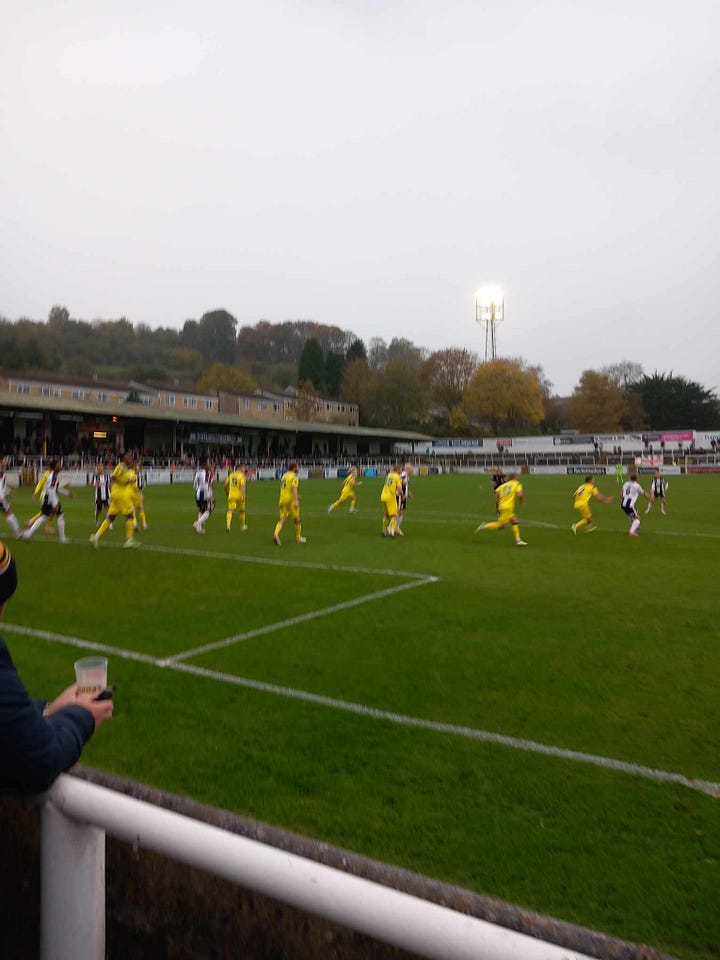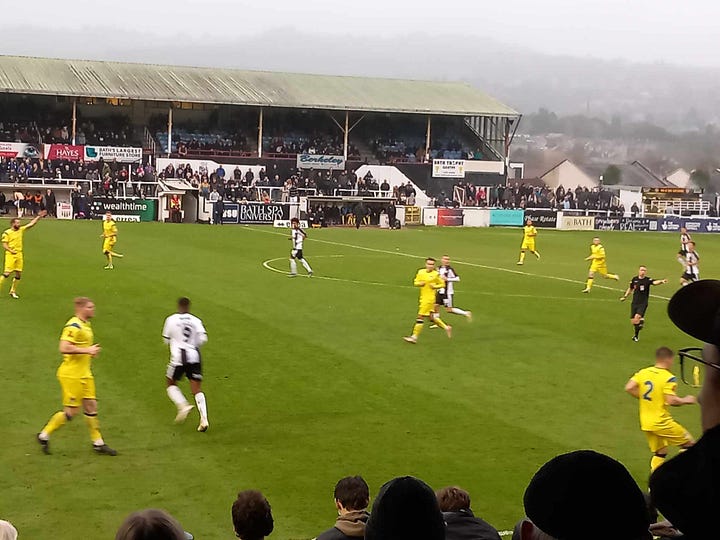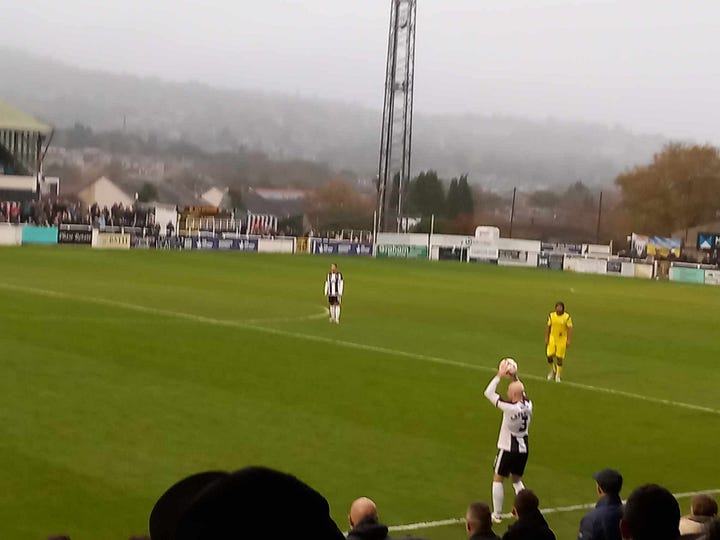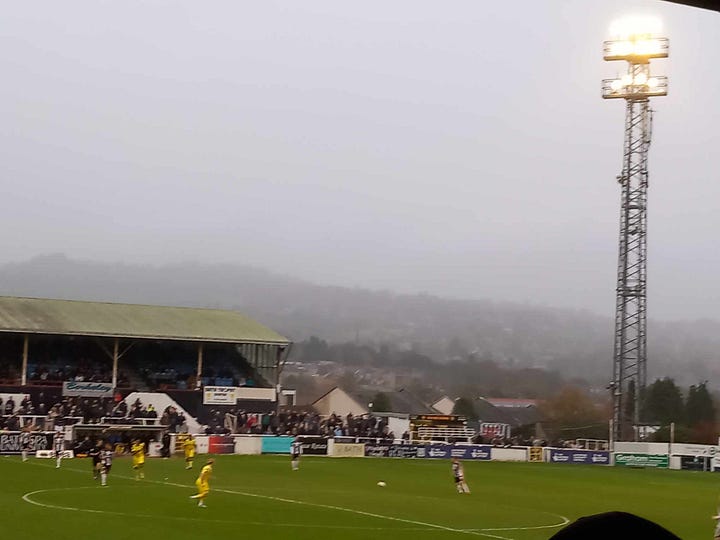Looking for Light in the Fog: A Day Out at Bath City
Bath may not be a footballing town, but Bath City FC understands community better than most. I looked into its symbiotic relationship with its fans ahead of a bleak match on a grim November day.
There’s a moment in Ken Loach’s 2009 comedy-drama Looking for Eric. Centreing around wayward, middle-aged postman Eric Bishop and his Manchester United-supporting friends, the scene in question contains some of the protagonists arguing about one of football’s constant pain points: the rift between money and community.
Sitting in a pub before a Champions League match, two of Eric’s friends berate each other over this time-honoured fracture. When one of them enters the pub wearing the shirt of lower-league grassroots club, his partner in pints says: ‘You can change your wife, change your politics or change your religion, but never ever can you change your football club’.
‘At least there’s not some fat bastard chairman selling us out for 30 pieces of silver’, retorts the newcomer.
It’s a fairly crass exchange, but it’s a pertinent allusion to a subject that has been at the heart of football discourse in recent decades. Loach’s clear sense for what football actually *means* to people comes from decades of supporting one of Southwest England’s most historic, undervalued and heart-on-sleeve clubs: Bath City.
The Second Sport
If you were to ask an outsider to describe the city of Bath, they’d probably draw a Ven diagram with the words ‘posh’, ‘Roman’ and ‘rugby’ comprising the three circles. An ancient town most famous for the baths that sit at its heart, it’s not a place that pulls any punches in terms of its vibe, history or presentation, not in the centre anyway.
It’s extremely proud of its cosy cobbled backstreets, immaculate Georgian and Victorian architecture and profound sense of class. And as is alluded to above, football has pretty much always played second fiddle to its older brother rugby.
If you’re based outside of Twerton, that is. Nestled away in the city’s north-west, Twerton is a community apart. Nudging up against university student accommodation and conservative retail parks, Twerton has a slightly dilapidated feel. The houses are modest to the point of being lo-fi, and garnering a friendly perception clearly isn’t a priority in some of the local pubs.
It's the sort of place where insular lower-league club fandom can thrive, and so it makes sense that Bath City should base themselves here. They’re not the biggest club to ever play at Twerton Park – that would be Bristol Rovers, bizarrely. But while they do have an incredibly rich history when it comes to league positioning and as a staple of the Southwest’s footballing scene, it’s not the sport that has grabbed the headlines, but the fans themselves.
Fans for Money, Money for Fans
In the story of Bath City, passionate fandom and finance go hand-in-hand, but not in the way you might expect. Since being founded in 1889, financial woes and crashes in funding have both dictated the club’s immediate fate and forged its future.
Just two years after their formation in 1891, Bath City’s coffers were so low that they amalgamated with the rugby club. This meant a complete cessation of sporting activity until 1900, when they were reformed by William Hyman. By August 1926, they were back in the red; a combination of bad football, poor supporter turnout and insufficient backing meant that the club was pretty much on the brink of extinction.
The solution though would set a romantic precedent that has come to define the club’s presence, identity and image over the ensuing 98 years. The fans formed a new supporters committee and encouraged a huge uptake in the amount of club shareholders, eventually raising the required £500 sum and thus turning the tables.
The most high-profile fiscal turnaround came in June 2015, when supporters launched the Big Bath City Bid. Spurred once again by poor finances and the desire to complete a fan takeover and turn Bath City into a thoroughbred community asset, supporters aimed to raise £750,000-1.25 million.
Serendipity is a powerful thing, and there’s nothing quite like a mass movement based on socialist principles to pique the interest of Ken Loach. A lifelong fan of the club, he very publicly backed the bid, assuring followers that it could ‘set us on the road for a successful future long-term’. He even managed to convince Looking for Eric co-star, Manchester United/French footballing icon and philosophising figurehead Eric Cantona to purchase shares in Bath City.
Like all good self-aware personalities – and Bath City *is* a personality as much as it is an institution – the club knows that its true value is in the people that surround it. That’s why when 269 supporters raised £51,899 in response to substantial league fines and COVID-related shortfalls, the club invested in structural stadium improvements, electrical upgrades and pitch drainage works.
Bath City aren’t the only club whose relationship with its fans is lovingly reciprocal, but it is probably the finest in England’s southwest.
Two Giant Killers?
The idea that Bath City exist in something of a cyclical poor form doom loop feels hard to escape on the morning of November 9th. They’ve not struck a progressive trajectory so far. They’re currently languishing just four places from bottom, having played 14, won 4, drawn 3 and lost 7.
A lack of conversion ability has been a glaring spectre, having only scored 10 goals. They’ve amassed just 15 points from a possible 42, so it’s fair to assume that the atmosphere at Twerton Park this afternoon probably isn’t going to be optimistic.
Weston-Super-Mare have far more reason to be joyful. They’re currently rolling strong at 3rd in the table, and are significantly firmer at both ends; they have scored 23 goals in their 13 games and conceded just 11. Whatever today’s result, it’ll be pitched as something of a David & Goliath story; either small coastal enclave Weston fell historic National League South giants, or the struggling big guns topple the high-achieving regional upstarts.
The Doom Loop Marches On
When I enter Twerton Park, the atmosphere is steely to say the least. Bath’s fairly woeful form so far this season doesn’t make up for the dour frosty mist that has descended on the ground and the surrounding area. The stands are markedly empty, which given City’s track record of tumultuous turnouts in bad times isn’t massively surprising.
There’s a bit more of a buzz by about 10 minutes before kick-off. The home stands are more fully stocked, but it’s still mostly the irreverent Weston-Super-Mare fans making the noise. And not even the stadium announcer can muster up a vibe that could be described as anything more than ‘subdued’.
By about 20 minutes into the game, all of that has changed. City have been the far better side so far thus far, and at this point it feels like only a matter of time until they score. As the first half goes on Weston manage a bit more presence, but it’s still the home side creating the better chances.




However – and perhaps predictably given how this season has gone so far – Bath’s more substantial playmaking doesn’t count for that much. On the stroke of half time, Sam Pearson puts the visitors ahead; it’s against the run of play and is so scrappy that it feels entirely preventable.
Clearly, whatever manager Jerry Gill said to the team in the break doesn’t install much stability. 51 minutes in, the lack of confidence in their defensive set up rears its unfortunate head as they plant the ball into their own net, much to the delight of the away fans just behind them. The realisation that City have very little to offer at the opposite end too is pretty tectonic for the rest of the half; the home team mostly look beaten and Weston are able to come at them in fairly easy waves.
Presence Speaks Volumes
So just how symbiotic is Bath City’s relationship with its fans? Clearly, fallow spells like the club is currently experiencing are painful for its local community. Nobody likes turning up to see genuinely defeatist performances like today’s, and there’s no immediate sign that an uptick in fortune is possible.
But if Looking for Eric is about anything, it’s about the way fans pull together during hard times, both for each other and for their club. The pain Eric is suffering in the movie, or the causes of it, isn’t as important to his friends as getting him through it is. Bath City clearly reflects the love of its fans, but it’s also easy to forget that on match days. What really matters for those 90 minutes is that people are here, for themselves, their friends or the team.








